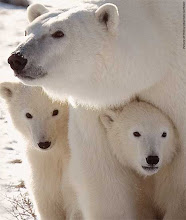With a disdain for science that alarms wildlife experts, Sarah Palin continues to promote Alaska's policy to gun down wolves from planes.
By Mark Benjamin
Sept. 8, 2008 | Wildlife activists thought they had seen the worst in 2003 when Frank Murkowski, then the Republican governor of Alaska, signed a bill ramping up state programs to gun down wild wolves from airplanes, inviting average citizens to participate. Wolves, Murkowski believed, were clearly better than humans at killing elk and moose, and humans needed to even the playing field.
But that was before Sarah Palin took Murkowski's job at the end of 2006. She went one step, or paw, further. Palin didn't think Alaskans should be allowed to chase wolves from aircraft and shoot them -- they should be encouraged to do so. Palin's administration put a bounty on wolves' heads, or to be more precise, on their mitts.
In early 2007, Palin's administration approved an initiative to pay a $150 bounty to hunters who killed a wolf from an airplane in certain areas, hacked off the left foreleg, and brought in the appendage. Ruling that the Palin administration didn't have the authority to offer payments, a state judge quickly put a halt to them but not to the shooting of wolves from aircraft.
Detractors consider the airborne shootings a savage business, conducted under the euphemism "predator control." The airplanes appear in the winter, so the wolves show up like targets in a video game, sprinting across the white canvas below. Critics believe the practice violates the ethics of hunting, while supporters say the process is not hunting at all, but a deliberate cull.
Palin has argued that she is worried about Alaska's hunters, locked in perennial competition with the canine carnivores for the state's prodigious ungulate population. A hunter herself, Palin has battled critics of aerial wolf hunting with the support of the Alaska Outdoor Council, a powerhouse advocacy and lobbying organization for hunting, fishing and recreation groups. In addition to so-called urban hunters, who shoot moose mostly for fun, Alaska is home to a significant number of subsistence hunters, including some of the Native population. Subsistence hunters rely on an occasional moose to make ends meet. The wolves, Palin has said, are stealing food from their tables.
"Palin acts like she has never met an animal she didn't want shot," says Priscilla Feral, president of Friends of Animals, based in Connecticut.
The controversy over Palin's promotion of predator control goes beyond animal rights activists recoiling at the thought of picking off wolves from airplanes. A raft of scientists has argued that Palin has provided little evidence that the current program of systematically killing wolves, estimated at a population of 7,000 to 11,000, will result in more moose for hunters. State estimates of moose populations have come under scrutiny. Some wildlife biologists say predator control advocates don't even understand what wolves eat.
State officials stand by their scientific findings on predator control. "Several times over the past several years, our science has been challenged in court," says Bruce Bartley, a spokesman for the Alaska Department of Fish and Game. "In every instance it has prevailed."
Yet it is not hard to find Alaskans who say Palin's enthusiasm for predator control fits a broader narrative of how she edits science to suit her personal views. She endorses the teaching of creationism in public schools and has questioned whether humans are responsible for global warming.
In 2007, she approved $400,000 to educate the public about the ecological success of shooting wolves and bears from the air. Some of the money went to create a pamphlet distributed in local newspapers, three weeks before the public was to vote on an initiative that would have curtailed aerial killing of wolves by private citizens. "The timing of the state's propaganda on wolf control was terrible," wrote the Anchorage Daily News on its editorial page.
"Across the board, Sarah Palin puts on a masquerade, claiming she is using sound management and science," says Nick Jans, an Alaskan writer who co-sponsored the initiative. "In reality she uses ideology and ignores science when it is in her way." The initiative was defeated last month.
Gordon Haber is a wildlife scientist who has studied wolves in Alaska for 43 years. "On wildlife-related issues, whether it is polar bears or predator controls, she has shown no inclination to be objective," he says of Palin. "I cannot find credible scientific data to support their arguments," he adds about the state's rationale for gunning down wolves. "In most cases, there is evidence to the contrary."
Last year, 172 scientists signed a letter to Palin, expressing concern about the lack of science behind the state's wolf-killing operation. According to the scientists, state officials set population objectives for moose and caribou based on "unattainable, unsustainable historically high populations." As a result, the "inadequately designed predator control programs" threatened the long-term health of both the ungulate and wolf populations. The scientists concluded with a plea to Palin to consider the conservation of wolves and bears "on an equal basis with the goal of producing more ungulates for hunters."
Apparently Palin wasn't fazed. Earlier this year she introduced state legislation that would further divorce the predator-control program from science. The legislation would transfer authority over the program from the state Department of Fish and Game to Alaska's Board of Game, whose members are appointed by, well, Palin. Even some hunters were astounded by her power play.
The legislation would give Palin's board "more leeway without any scientific input to do whatever the hell they basically wanted," Mark Richards, co-chair of Alaska Backcountry Hunters and Anglers, wrote in an e-mail. The legislation is currently stalled in the Alaska state Senate.
Predator control in Alaska dates back to the 1920s and 1930s. Even then, wildlife biologists insisted that wolves were important to the area's natural ecology and not responsible for inordinate deaths of sheep, caribou or moose. Yet the scientists fought a losing battle against ranchers, hunters and government officials, who backed the extermination of tens of thousands of wolves. Aerial hunting began in earnest in the 1940s and continued through the 1960s after Alaska had earned statehood.
But starting in 2003, Murkowski opened the airborne shooting to citizens with special permits and expanded predator-control programs to cover 60,000 square miles of state and federal land, the largest wolf-killing operation since Alaska became a state. The stated goal is to reduce wolf populations in some areas by 60 to 80 percent. Teams of pilots and gunners have killed at least 795 wolves since 2003. Conservationists counter that the total number of wolves trapped, shot from airplanes, chased down by snow machines, and killed legally and illegally in Alaska every year is more along the lines of 2,000.
Scientists insist that the Palin administration is systematically killing wolves with an inadequate understanding of the relationship between the carnivore and hoofed animals. The state responds that predators kill over 80 percent of the moose and caribou that die each year, while hunters and trappers kill less than 10 percent.
Haber says the state's numbers are wildly inflated. His decades of wolf research have shown that wolves are, in fact, mostly scavengers. "Sixty to 70 percent of the moose they eat are scavenged, not killed," he says. He adds that the state's wolf population estimates, based on secondhand observations and extrapolations, are also high.
Palin offered the $150 bounty for wolf paws in 2007 after efforts to kill wolves from airplanes that season were, in her view, coming up short. State officials had hoped that 382 to 664 wolves would be killed during that predator-control season. State officials were disappointed when only 115 wolves were killed from the air.
Palin thought the $150 cash bounties would do the trick. Haber has another explanation for the dry spell. "I can tell you from my own research that the reason they didn't get many wolves in certain years, particularly last winter, is because they have scraped those areas clean," he says.
Last year, Rep. George Miller, D-Calif., introduced legislation designed to curtail predator-control programs, except as a last resort. "It's time to ground Alaska's illegal and inhumane air assault on wolves," Miller said. Palin quickly fired off a curt letter in response, applauding the state's programs as "widely recognized for their excellence and effectiveness." She pointed out that her state has "managed its wildlife so that we still maintain abundant populations of all of our indigenous predators almost fifty years after statehood."
Says Jans, co-sponsor of the losing initiative to outlaw aerial wolf hunting: "This is a reflection of a somebody who doesn't have any use for science."
Subscribe to:
Post Comments (Atom)


























1 comment:
And who are the "alarmed" wildlife experts? Gov. Palin supported funding for gathering scientific data regarding predator/prey wildlife management from day one. Check the real wildlife biologist's publications on the Alaska Department of Fish & Game website; Predator Control In Alaska. If Gloria Steinam doesn't like Palin fine, but pick a good reason for yourself to support or oppose Palin. This one is just stinky meat.
Post a Comment